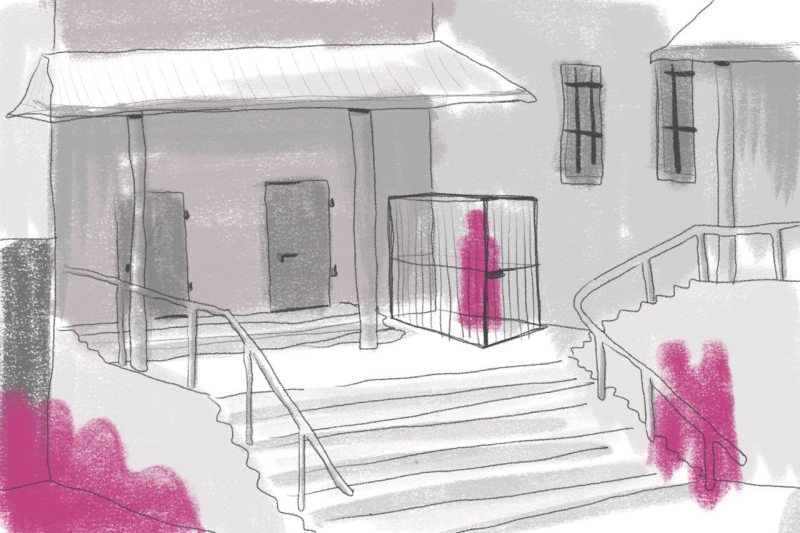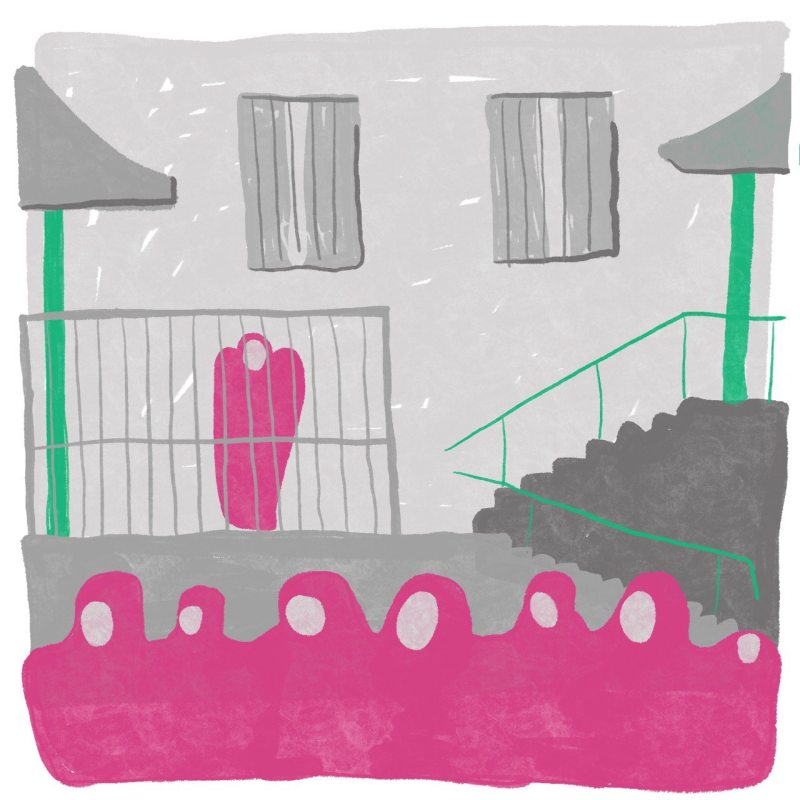The "cage" in women's penal colonies. What is it, what norms does it violate?
In women's colony No. 4, there are many punishments that infringe upon the honor and dignity of a person. One of these is the placement of political prisoners in the so-called "cage", which is located outside, between the residential and industrial areas. As part of the Week against Torture, which is organized by the Legal Initiative on the eve of the UN International Day in Support of Victims of Torture, Viasna writes about what it is and what national and international norms such treatment of prisoners violates.
What does a "cage" look like?
It is a real cage, about one and a half meters long and about two meters wide. The cage stands between the residential and industrial areas, on the steps in front of the factory gate. It is a rectangular cage with metal bars, and it is similar to the ones people are held in during the trial.
Often people are placed there in the cold season to make the punishment worse. People are usually held there from one to three hours, and some political prisoners say that it can last up to four hours. If you stay there until nightfall, you can lose your lunch. More often than not, if you get into such a cage, then you will be later placed in a solitary confinement cell (SHIZO).
Why are people put there?
People get there for being guilty of something: for example, when there is a fight or some other incident. They can be placed there even for disagreeing with the opinion of the administration or a refusal to work. They also get there for prevention, so that others can see that a person has committed some kind of misconduct. Misconduct always includes a great variety of actions. For example, a person can be put there to calm down if they have a breakdown, or because they sewed a button improperly.
In a dialogue with one of the political prisoners, the head of the regime department of the colony said that people are put in a cage for the time the administration needs to figure out whether the person had done something wrong or not. The political prisoner recalls:
"He explained: this cage is used in case there is some kind of violation of the daily schedule or something else like the internal regulations, and the convict can be placed there. She is usually there until the circumstances are clarified and when they choose how to deal with this offense."
After a person is put there, the punishment board has a meeting; the board includes people from all departments of the colony: operation, regime, and correction departments. The head of the colony and one of the psychologists are always present.
How does it feel?
Sometimes it is called the "cage of shame", since it is for such purposes that people are put there. Former political prisoner Darya Chultsova called it an equivalent of the pillory in the Middle Ages:
"You can only stand there. There is not even a chair in it. And if you sit on the ground, the time spent in this "room" may increase. People are put in the "cage" in any weather and any mood. They are often sent to SHIZO directly from there.
There's nowhere to turn around in it, and dozens of people pass by, look at you, and think, "What has she done?" The administration, which is supposed to "re-educate," walks around and sneers at you."
One of the political prisoners notes that she saw a woman in a cage who demonstrated her protest there, and another who stood there and was constantly smiling.
Comment by Viasna legal service:
Putting a person in a "cage " is contrary to international and national law.
|
Part 2, Article 10 of the Penal Enforcement Code Convicted persons should not be subjected to cruel, inhuman, or degrading treatment. Coercive measures can be applied to them only on the basis of the law. |
The right to freedom and personal integrity is violated
|
The Nelson Mandela Rules Rule 39 1. No prisoner shall be sanctioned except in accordance with the terms of the law or regulation referred to in Rule 37 and the principles of fairness and due process. |
Among the penalties listed in Article 112 of the Penal Enforcement Code, there is no provision for placing a person in a cage in the yard, which other convicts pass by.
Thus, putting a person in a cage for being suspected of committing a disciplinary offense violates the right to freedom and personal integrity, since such deprivation of liberty does not comply with the form and procedure of detention established by law. That is, it cannot be justified on any legal basis and, therefore, is illegal and arbitrary (Article 9 of the ICCPR).
The right not to be subjected to cruel, inhuman, or degrading treatment and the right to humane treatment and respect for the inherent dignity of the human person are violated.
|
General comment No. 21 of the Human Rights Committee, Article 10 4. Humane treatment of all persons deprived of their liberty, with respect for their dignity, is a fundamental rule of universal application. |
|
The Nelson Mandela Rules Rule 47 1. The use of chains, irons, or other instruments of restraint which are inherently degrading or painful shall be prohibited. |
A person who is sentenced to imprisonment and is isolated from society is placed in a cage that is publicly visible to other convicts. The cage is located outside. The person feels humiliated. It is cold or hot and uncomfortable in the cage. The person experiences moral and physical suffering.
Thus, staying in it violates the right not to be subjected to cruel, inhuman, or degrading treatment and the right to humane treatment and respect for the inherent dignity of the human person (Articles 7, 10 of the ICCPR).



















